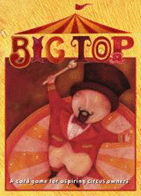
|
About OgreCave and its staff
|

|
by Matthew Pook
Better known for its SF combat game Dark Horizon, APE recently released two new card games. While Anathema is based upon the Salem Witch Trials, Big Top has a circus-based theme. Designed for three to six players age eight and over, it is based upon the children's game Fan Tan. The aim is to be the richest and most successful circus owner through playing all of the cards from a player's hand, though it is also possible to make money during a round rather than just at the end.
Under the Tent The Organizing Charts, each about eight inches long and three deep, are marked with four spaces corresponding to the suits which a player invests their Gate Receipt Tokens into at the start of a round, one per square. These tokens are worth $3, $5, $7 and $10, and total $25. Four other spaces are marked in descending order $3, $2, $1 and $0, and are where Called Cards are placed. Between the two sets of spaces is the scoring track. This runs from one through twenty - if a player's score rises above this, their scoring token can be turned over to denote this fact. One problem with the components is that they do not quite all sit in the box, as the tray that holds the cards stands too high in the base. Plus there is nowhere for the various tokens to be stored, increasing the chances of them being lost. A round begins with all of the cards being dealt out and the players investing their Gate Receipt Tokens depending upon which suits they think they will be able to empty from their hand during the round. Then they take turns playing cards, one per player. Poster cards must be played first, then the number cards from one to six in ascending order. The dark numbered cards go on one pile, the light numbered on another, and both get placed beside their suit poster card. If no card can be played onto a pile, then a card is put down from the player's hand onto the highest value Called Card space on the Organizing Chart. On subsequent turns this and any other Called Cards will move along the chart from the space marked $3 toward the $0 space, thus decreasing in value. A Called Card must be played onto an appropriate pile if the number below it has been played. Points can also be scored if a card played from the hand onto a pile matches both the suit and shade of any of the Called Cards on the opposing player's Charts. These points are equal to the space the scoring Called Cards currently sit upon. Once a player totally empties their hand of cards, they gain the full value of their Gate Receipt Tokens. The other players gain the value they invested in at the start of the round for each suit they divested their hands of. Then everything resets and more rounds are played until everyone has been the dealer. The player with the highest score is the winner.
Conclusions At its heart, Big Top is a nice simple game well suited for family play. Unfortunately, the rules are anything but simple. It took several close readings to really understand how the game is played, and if it was difficult for our playing group, then an eight-year old is going to have a very hard time. Adult help in deciphering the rules is all but mandatory, but once a younger player has grasped them, playing again should not be a problem. The rules come with an example of play, but it does not help as much as it should. Notes are also provided on playing Fan Tan with Big Top cards. I am not familiar with Fan Tan, but this game feels similar to the Australian family game, Skipbo, and has similarities to Hearts as well. The game has some nice touches, such as the first player being determined by last person who went to the circus, and interesting flavor text. But even taking those into consideration, ultimately Big Top is a simple game let down by a lack of clarity to its rules.
|
||
 Big Top:
Big Top: